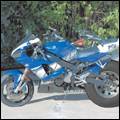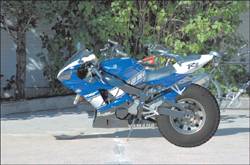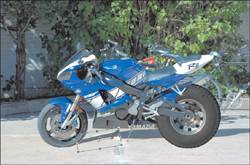Project 3. Outrageous Choppers There seems to be a large interest in choppers recently. In fact, interest seems to be stronger than it was in the 1960s and 1970s. There are even a number of television shows based on the people who create some of these amazing machines. Even if you don't ride, you have to appreciate the beauty of some of the machines these people build.  What I'd like to do with this particular project is honor some of those crazy chopped motorcycles and their builders/creators with one of my own making. Of course, this won't be a real chopper, and probably couldn't be built in real life, but isn't that part of the fun of a digital darkroom? You bet it is! We'll actually be creating a monster drag bike from one of the racing bikes many riders seem so fond of. I know these bikes are fast, but let's see if we can add some speed-enhancing improvements. To get started, open a file that contains a shot of a motorcycle. You can download the one I'm using from the companion website, or you can use your own. If you want to work with a shot of your own, make sure that when you shoot it, you get down a little so the bike is as centered as possible. You can see the photo I'll be working with in Figure 3.18. Figure 3.18. A digital snapshot of a motorcycle. 
Boy, you can tell that thing's fast just by looking at it. Let's see if we can turn it into a bit of a dragster, though. To add to the "monster-ism" aspect of this project, I'll borrow the wheels from the truck photo of the first project in this chapter. 1. | With both photos open, activate the truck photo and use the Selection tool; then with the Selection Type set to Circle, select one of the back wheels of the truck. You can draw guides through the wheel's center as we did in the previous project when we selected the mag from one of the truck wheels.
Tip If you plan to do more projects like the ones in this book, you might want to consider creating a folder where you can keep bits and pieces of images to be reused in other projects. For example, the truck wheel from the first project in this chapter makes an appearance in both the second (Virtual Race Cars) and third (this one) projects. Eventually, you'll find that you have quite a collection of odds and ends that can be used for many different projects. | 2. | With the wheel selected, select Edit, Copy Merged (if it has lots of layers, you want to make sure you actually get the wheel).
You can close the truck file, because it is no longer needed for this project.
| 3. | Activate the motorcycle image by clicking its title bar. Then select Edit, Paste As New Layer to paste the truck wheel into the motorcycle image.
| 4. | Using the Pick tool, resize and place the wheel (see Figure 3.19).
Figure 3.19. Adding a large truck wheel and tire to the rear end of the motorcycle. 
| 5. | As you can see from Figure 3.20, I've left the wheel, let's not say ludicrously large, but…okay, let's say itI've left the wheel rather large. Of course, that's part of the point of this outrageous chop job, isn't it?
Figure 3.20. Painting in a mask to hide some of the new rear wheel. 
|
Using a Mask to Blend the Wheel In I'd like some of the motorcycle to show through around the new wheel. We could simply erase parts of the wheel, but if we did that it would cause problems if we decided to move the wheel even a little bit. Instead of erasing the wheel, we'll use the power of a mask to hide parts of the wheel so the underlying motorcycle photo can show through. The concept is pretty simple: Where the mask is white the wheel will be visible, and where the mask is black the wheel will be invisible. Masks are grayscale, but we'll only really need black and white. To help you see which parts you'd like to make visible, you can activate the truck wheel layer and lower its opacity. Be sure to reactivate the mask layer before you start painting again, though.
6. | Right-click the layer with the truck wheel and select New Mask Layer, Show All. You'll now have a mask layer filled with white above the truck wheel layer.
| 7. | Select the Paint Brush tool and set the foreground color to black.
| 8. | Paint over the areas of the motorcycle you want exposed. Parts of the fender, for example, along with parts of the suspension could be brought out to help with the illusion.
You can see the results of my efforts in Figure 3.20. Note that I left out some details, such as the chain. I didn't feel that it added to the illusion, so I decided to leave it off. Feel free to play around with both ideas to see what works best for you.
Figure 3.20 also shows the mask layer. It's small, but you should be able to make out the black squiggle where I "painted" out the wheel.
|
One Wheel Washes the…No Wait, That's Not Right With the back wheel's work completed, it's time to lavish some attention on the front wheel. A truck wheel on the front of a motorcycle. Don't be ridiculous. The back I can see, but the front? Nah. Instead, let's level the whole bike off by extending the front fork. Hey, is this a chopper, or not? 9. | Make the motorcycle layer active by clicking its layer in the Layers palette. Then use your favorite selection tools/methods to select the front wheel and fork of the motorcycle. If you need a bit of a refresher on making selections, take a look at Appendix B,"Paint Shop Pro X in a Nutshell," before proceeding.
Of course, we'll only level the bike off. Tilting it up would take quite a bit more work. If you feel comfortable enough with the work being done in these projects, you can give it a try. All you need to do is select the entire bike and copy it to a new layer. When you have it there, use the Pick tool to tilt the bike to the desired angle. With that done, follow along with the rest of the work being done on the front end but make the fork extension long enough to join the bike with the front wheel.
| 10. | With the front wheel selected, select Edit, Copy. Then select Edit, Paste As New Layer to paste the copy of the front wheel to its own layer. Use the Pick tool to move the wheel into position (see Figure 3.21).
Figure 3.21. Move the copy of the front wheel into place. 
You can see in Figure 3.21 that I've moved the copied wheel down and forward a little. I basically want it lined up horizontally with the new back wheel and lined up in such a way as to make the front forks one straight line.
|
Out with the Old With a copy of the front wheel tucked safely away on its own layer, it's time to hide the old one. The best way to do so is to use the Clone Brush tool to copy parts of the sidewalk, trees, and so on over the front wheel. To make it easy to step back, though, you can paint with the Clone Brush to a new layer. See Appendix B if you need to improve your cloning skills. 11. | Select the Clone Brush tool. I set the size of the brush so that it was about as big as the curb in the background, and I chose Use All Layers and Aligned mode.
| 12. | Make the new front wheel layer invisible by clicking its visibility icon in the Layers palette. You don't want to clone the new wheel over anything else in the image.
| 13. | Activate the layer with the motorcycle photo. Then click the small arrow in the icon in the upper-left corner of the Layers palette and select New Raster Layer. I named it Cloned out Front Wheel.
| 14. | Use the Clone Brush to clone areas of the sidewalk and background over the existing front wheel (see Figure 3.22). When you're finished, make the layer with the new front wheel active again to see how it turned out.
Figure 3.22. Clone out the existing front wheel. 
| 15. | Use the Clone Brush tool to copy a section of the front fork so it connects the existing front fork with the part of it that came along with the front wheel. Use the Eraser tool to clean up the pasted new front wheel, if necessary. You can see my version in Figure 3.23.
Figure 3.23. The monster bike just needs a bigger shadow to go with its new attitude. 
|
Fixing the Shadow All that's left is to fix the shadow. You'll need your best cloning skills for this task. We need to extend the shadow so the new rear wheel and extended front wheel have a shadow that matches their new positions. We'll also need to get creative. The back wheel won't be badit just needs to be enlarged along the bottom. To be a good fake, though, the front wheel and fork shadow doesn't need to be enlarged, but shifted or tilted. I think a selection copied and pasted to a new layer before the application of the Clone Brush might work best. 16. | Activate the Motorcycle layer by clicking its layer in the Layers palette. Then make a selection around the existing shadow about two-thirds of the way from the front wheel to the motorcycle's stand.
You can use the Selection tool with a Rectangle Selection Type or an Ellipse Selection Type. If you're brave, you might even give the Freehand tool a try. Just be sure you leave a little bit of the non-shadow area within your selection. It'll help to blend it later.
| 17. | Select Edit, Copy; then select Edit, Paste As New Layer. Select the Pick tool and use it to rotate the copy of the shadow into place, moving it as necessary (see Figure 3.24).
Figure 3.24. Fixing the shadow of the front wheel. 
| 18. | Use the Clone Brush tool to fix the area where the copied shadow meets the original. Be sure you do your cloning to a new layer and that you set the option to Use All Layers.
You can clone the back wheel's shadow to the same layer. Remember that you can always press Ctrl+Z to undo and try again.
This image is a good example of how changing the brush size and hardness can make a big difference. I used a smaller brush for the front than I did for the back wheel and, after I initially started cloning, I realized that my shadow didn't quite match. So, I reset the Hardness from 75 to 50. That made a big difference.
You can see my final image in Figure 3.25.
Figure 3.25. The final "monster" bike. 
|
|








